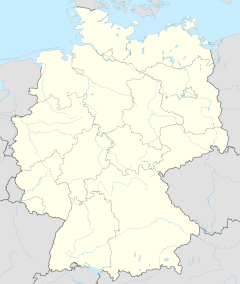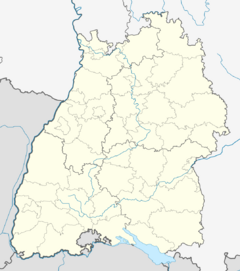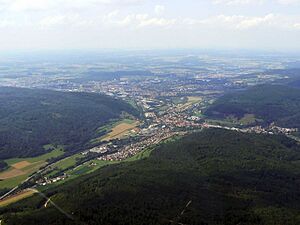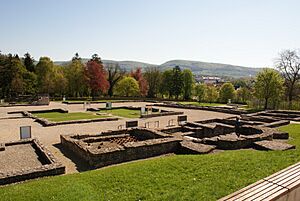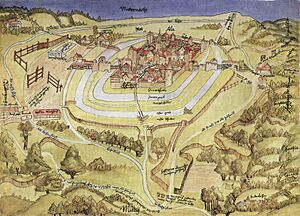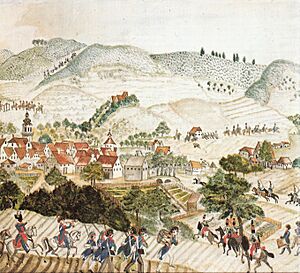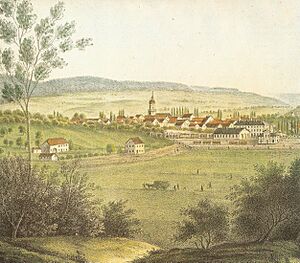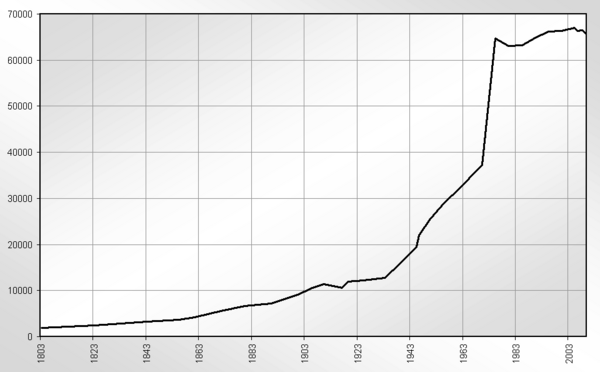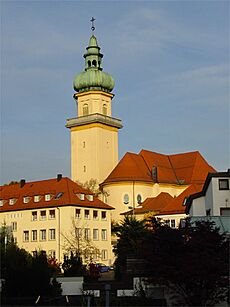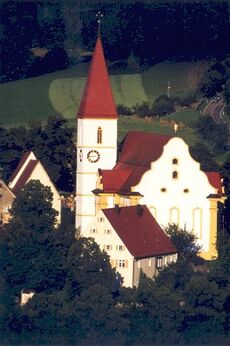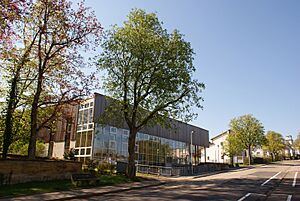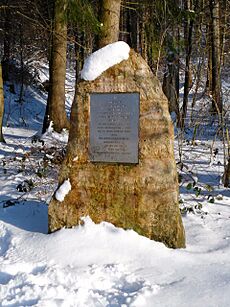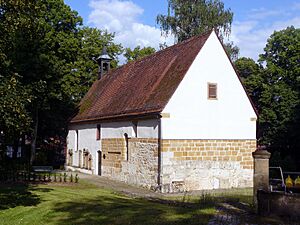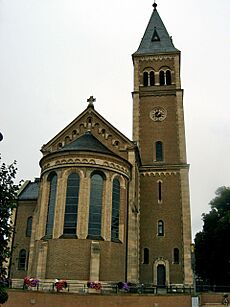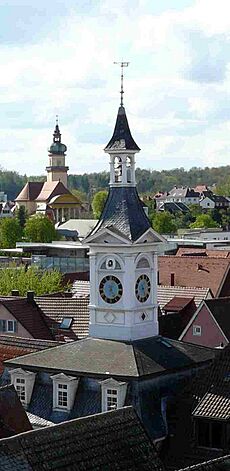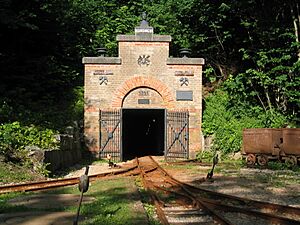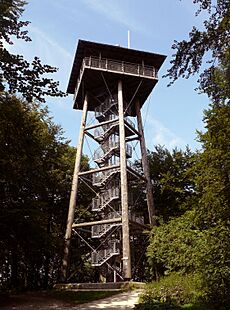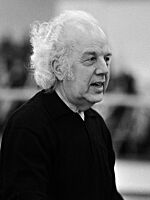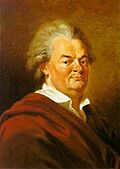Aalen facts for kids
Quick facts for kids
Aalen
|
|||
|---|---|---|---|
 |
|||
|
|||
|
Location of Aalen within Ostalbkreis district
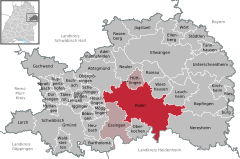 |
|||
| Country | Germany | ||
| State | Baden-Württemberg | ||
| Admin. region | Stuttgart | ||
| District | Ostalbkreis | ||
| Area | |||
| • Total | 146.63 km2 (56.61 sq mi) | ||
| Elevation | 430 m (1,410 ft) | ||
| Population
(2022-12-31)
|
|||
| • Total | 68,816 | ||
| • Density | 469.317/km2 (1,215.53/sq mi) | ||
| Time zone | UTC+01:00 (CET) | ||
| • Summer (DST) | UTC+02:00 (CEST) | ||
| Postal codes |
73430–73434
|
||
| Dialling codes | 07361/-66/-67 | ||
| Vehicle registration | AA | ||
| Website | www.aalen.de | ||
Aalen is a cool town in the eastern part of Baden-Württemberg, a state in Germany. It's about 70 kilometers (43 miles) east of Stuttgart and 48 kilometers (30 miles) north of Ulm. Aalen is the main town of the Ostalbkreis district and the biggest town in the Ostwürttemberg area. Since 1956, Aalen has been a "major district town," which means it has special responsibilities. It's famous for its many old half-timbered houses, built between the 16th and 18th centuries.
Aalen covers an area of about 146.63 square kilometers (56.61 square miles). This makes it the 7th largest town in Baden-Württemberg. With about 66,000 people living there, Aalen is also one of the most populated places in the state.
Contents
- Exploring Aalen's Geography
- Aalen's Rich History
- Aalen's Religions
- Twin Towns and Sister Cities
- Culture and Fun in Aalen
- Aalen's Economy and Transport
- Notable People from Aalen
- See Also
Exploring Aalen's Geography
Where is Aalen Located?
Aalen is located near the Kocher river, at the bottom of the Swabian Jura mountains. These mountains are to the south and southeast of the town. To the north, you'll find the hilly Ellwangen Hills.
The Kocher river flows into Aalen from the south, goes through the town center, and then leaves towards Hüttlingen. A small river called the Aal also flows into the Kocher right in the town center. Other rivers like the Rems and the Jagst start near Aalen too.
The town center is about 430 meters (1,411 feet) above sea level. The highest point in Aalen is the Grünberg's peak, which is about 733 meters (2,405 feet) high.
Aalen's Unique Geology
Aalen is known as a "Geologist's Mecca" because its land shows all the different rock layers from the Jurassic Period. The town center sits on "Brown Jurassic" rocks, and other parts have "White Jurassic" and "Black Jurassic" layers.
The area is especially known for the Opalinuston-Formation (Opalinum Clay Formation), which is part of the Aalenian subdivision of the Jurassic Period. This period is actually named after Aalen! You can also find "Iron Sandstone" and lots of sand and gravel in the hills around the city. The old part of Aalen is built on recent river mud and gravel.
Did you know? Until 1939, people used to mine iron ore on the Braunenberg hill near Aalen.
How Big is Aalen?
Aalen stretches about 18 kilometers (11 miles) from north to south and 25 kilometers (16 miles) from east to west. The total area is about 146.63 square kilometers (56.61 square miles). A lot of this land is used for farming (42.2%) and forests (37.7%). About 11.5% is built-up areas, and 6.4% is used for roads and other transport.
Aalen's Districts and Villages
Aalen is made up of its main town center and several smaller towns and villages that joined Aalen over time, mostly between 1938 and 1975. These merged areas are called Stadtbezirke (districts). Each district has its own local council and a spokesperson.
Here's a quick look at the main districts and some of their villages:
Aalen's Climate
Aalen has a good amount of sunshine, about 1800 hours a year, which is more than the average for Germany. However, it also gets a fair bit of rain, with about 167 days of precipitation each year. The average temperature is about 9.9 degrees Celsius (49.8 degrees Fahrenheit), which is warmer than the average for Germany.
| Climate data for Aalen | |||||||||||||
|---|---|---|---|---|---|---|---|---|---|---|---|---|---|
| Month | Jan | Feb | Mar | Apr | May | Jun | Jul | Aug | Sep | Oct | Nov | Dec | Year |
| Mean daily maximum °C (°F) | 2 (36) |
4 (39) |
9 (48) |
14 (57) |
18 (64) |
21 (70) |
23 (73) |
23 (73) |
20 (68) |
13 (55) |
7 (45) |
3 (37) |
13 (55) |
| Daily mean °C (°F) | 1.2 (34.2) |
2.0 (35.6) |
5.5 (41.9) |
9.4 (48.9) |
14.3 (57.7) |
17.5 (63.5) |
19.2 (66.6) |
18.9 (66.0) |
14.2 (57.6) |
10.0 (50.0) |
4.6 (40.3) |
1.4 (34.5) |
9.9 (49.7) |
| Mean daily minimum °C (°F) | −4 (25) |
−3 (27) |
0 (32) |
4 (39) |
8 (46) |
11 (52) |
12 (54) |
12 (54) |
9 (48) |
5 (41) |
1 (34) |
−2 (28) |
4 (40) |
| Average precipitation mm (inches) | 54.5 (2.15) |
50.8 (2.00) |
74.3 (2.93) |
55.4 (2.18) |
79.4 (3.13) |
68.7 (2.70) |
87.9 (3.46) |
80.8 (3.18) |
67.6 (2.66) |
72.4 (2.85) |
59.0 (2.32) |
56.1 (2.21) |
806.9 (31.77) |
| Average rainy days | 16 | 13 | 12 | 14 | 14 | 15 | 15 | 14 | 14 | 12 | 15 | 13 | 167 |
| Mean monthly sunshine hours | 62 | 84.75 | 155 | 180 | 217 | 210 | 248 | 217 | 180 | 124 | 60 | 62 | 1,799.75 |
Aalen's Rich History
Early Settlements and Roman Times
People have lived in the Aalen area for a very long time! Tools from 8,000 to 5,000 BC have been found. There was even a hill-top settlement from the Bronze Age. Ancient Celtic coins and burial mounds have also been discovered.
Around 150 AD, the Roman Empire built a large fort in Aalen. This fort housed about 1,000 horsemen and was the biggest Roman cavalry fort along the Rhaetian Limes, a border defense system. There were also civilian settlements next to the fort. Around 260 AD, the Romans left, and the Alamanni people took over the region.
How Aalen Was Founded
Archaeologists believe Aalen started around the 7th century, based on old graves found. The first time Aalen was mentioned in writing was in 839. The town itself was officially founded by the Hohenstaufen family between 1241 and 1246.
Aalen as an Imperial City
|
Imperial City of Aalen
Reichsstadt Aalen
|
|||||||||||
|---|---|---|---|---|---|---|---|---|---|---|---|
| 1360–1803 | |||||||||||
| Status | Imperial Estate | ||||||||||
| Capital | Aalen | ||||||||||
| Government | Republic | ||||||||||
| Historical era | Early modern period | ||||||||||
|
• Town founded
|
13th century | ||||||||||
|
• Gained Imperial immediacy
|
1360 | ||||||||||
| 1575 | |||||||||||
| 1628–32 | |||||||||||
|
• Devastated by fire
|
1634 | ||||||||||
|
• Mediatised to Württemberg
|
1803 | ||||||||||
|
|||||||||||
|
Before 1360, the town belonged to the Counts of Oettingen who pawned them into the County of Württemberg in 1358 or 1359.
|
|||||||||||
In 1360, Emperor Charles IV declared Aalen an Imperial City. This meant Aalen was only answerable to the emperor, making it almost like its own small country until 1803. In 1398, Aalen gained the right to hold markets, which was a big deal for trade.
An old picture from 1528 shows Aalen surrounded by walls, towers, and double moats. The town had two main gates, the Ellwangen Gate in the east and the Gmünd Gate in the west. The main market street stretched between these gates.
In 1575, Aalen adopted the Protestant Reformation, changing its main religion.
The Great Fire of 1634
On September 5, 1634, during the Thirty Years' War, a big fire destroyed parts of Aalen. Some say the church and almost all buildings were burned down. The town archive, with all its important documents, was also lost. It took nearly 100 years for Aalen to recover and for its population to grow back to 2,000 people.
French troops marched through Aalen several times in the late 1600s and early 1700s during different wars. In 1765, the town church's tower collapsed, destroying the church again. It was rebuilt into the church you see today.
End of the Imperial City Era
During the Napoleonic Wars, Aalen was looted in 1796. In 1803, Aalen lost its "Imperial City" status and became part of the Duchy of Württemberg. In 1805, Napoleon Bonaparte himself visited Aalen with a huge army.
As times changed, the old town walls were no longer useful. Starting in 1800, most of the towers and other old buildings were taken down.
The Industrial Revolution in Aalen
Before factories became common, Aalen's economy was mostly farming and crafts like tanning leather and weaving. The town had many tanneries because it was close to Ulm, a big market for leather.
Industrialization came slowly to Aalen. The biggest change happened in the 1860s when the railway network arrived. The Rems Railway opened in 1861, connecting Aalen to other cities. This brought more industries, like the royal steel mill in Wasseralfingen. Aalen became a major railway hub with many jobs related to trains. This is why historians sometimes call Aalen a "railwayman's town."
The town also started getting modern services: gas lighting in 1866, a water supply system in 1870, and electricity in 1912.
After World War I, Aalen built new housing areas. Even during the Great Depression in 1929, the town modernized its public baths.
Aalen During World War II
During the Nazi rule, Aalen saw the construction of several military offices. In 1938, some nearby villages were merged into Aalen.
Sadly, a concentration camp called Wiesendorf was built near Aalen in September 1944. About 200-300 prisoners were forced to work in nearby factories. Around 60 prisoners died there before the camp closed in February 1945. Other labor camps also existed, where prisoners of war and people from occupied countries were forced to work for the arms industry.
Luckily, Aalen avoided most of the fighting during World War II. However, in the last weeks of the war, Aalen was bombed by planes. The train station and other railway buildings were hit. On April 17, 1945, a major air attack killed 59 people and destroyed many homes. Five days later, US forces took over Aalen.
Aalen After the War
After World War II, Aalen became part of the new state of Baden-Württemberg in 1952. In 1973, Aalen became the main town of the new Ostalbkreis district. In 1975, Aalen merged with Wasseralfingen, making the town much larger.
Aalen's population grew a lot after the war, partly because many refugees came to live there. In 1946, the population passed 20,000, which gave Aalen the special status of "major district town" in 1956.
Aalen's Population Over Time
For many centuries, Aalen was a small town with only a few hundred people. Its population grew slowly due to wars, hunger, and diseases. But in the 19th century, with the start of the Industrial Revolution, Aalen began to grow much faster. In 1803, there were only 1,932 people, but by 1905, it had grown to 10,442!
After World War II, many refugees came to Aalen, and the population jumped to over 31,000 by 1961. When Aalen merged with Wasseralfingen in 1975, the population reached over 65,000.
As of 2008, Aalen had about 66,058 people. The average age of people in Aalen has increased a bit over the years. About 9.56% of the residents are from other countries, with the largest groups coming from Turkey and Italy.
Aalen's Religions
Aalen has a mix of religions. In 2008, about 51.1% of people were Catholic, and 23.9% were Protestant. About 25% belonged to other religions or no religion.
Protestantism in Aalen
Aalen became mainly Protestant in 1575 during the Reformation. The main Protestant church in Aalen is St. Nicholas' Church, built between 1765 and 1767. Another old church is St. John's Church, which might be from the 9th century! As Aalen grew, more Protestant churches were built, like St. Mark's and St. Martin's.
Catholicism in Aalen
For a long time, Catholics in Aalen's main area went to church in Unterkochen. But in 1872, Aalen got its own Catholic parish again. St. Mary's Church was built in 1868, and later, Salvator's Church (1913) and Holy Cross Church (1969) were added. Many of the merged districts like Dewangen, Ebnat, Hofen, Waldhausen, and Wasseralfingen remained mostly Catholic after the Reformation, so they have very old churches.
Hofen's Saint George's Church is a fortified church, meaning it was built to be defended. Wasseralfingen has a beautiful Romanesque-style St. Stephen's Church, built between 1881 and 1883.
Other Religions in Aalen
Besides Protestants and Catholics, Aalen also has other Christian groups like the United Methodist Church and Baptists.
Aalen also has an Islamic community with two mosques, the D.I.T.I.B. Mosque of Aalen and the Fatih Mosque, both on Ulmer Straße.
Twin Towns and Sister Cities
Aalen is twinned with several cities around the world. This means they have special friendly relationships and often exchange sports teams, cultural groups, and students.
 Saint-Lô, France (since 1978)
Saint-Lô, France (since 1978) Christchurch, United Kingdom (since 1981)
Christchurch, United Kingdom (since 1981) Tatabánya, Hungary (since 1987)
Tatabánya, Hungary (since 1987) Antakya, Turkey (since 1995)
Antakya, Turkey (since 1995) Cervia, Italy (since 2011)
Cervia, Italy (since 2011) Vilankulo, Mozambique (since 2018)
Vilankulo, Mozambique (since 2018)
Culture and Fun in Aalen
Theatre and Music
The Theater der Stadt Aalen (Theatre of the Town of Aalen) puts on many shows each year.
Aalen also has a "Music School" with about 1,500 students. There's even a symphony orchestra called Aalener Sinfonieorchester that performs three concerts a year. Aalen also hosts the Aalen Jazzfest every November, bringing famous musicians to town.
Did you know that the famous German rapper and singer, Cro, was born in Aalen and lived there when he was young?
Museums and Cool Places to Visit
Aalen's Museums
Aalen has some interesting museums! The "Aalen Limes Museum" is built on the site of the old Roman cavalry fort. You can see many Roman objects there. The ruins of the fort are right next to the museum. Every two years, they even have a Roman festival there!
In the Historic Town Hall, you can find the Geological-Paleontological Museum. It has over 1,500 fossils from the Swabian Jura, including ammonites and ancient sea creatures.
Memorial Sites
There are places in Aalen that remember important events. In Wasseralfingen, there's a memorial stone for prisoners who died in a concentration camp nearby during World War II. In the cemetery, there's a memorial for forced laborers.
On the Schillerhöhe hill, there's a bell tower built in 1954 to remember Aalen's victims of both world wars. The bell rings every evening.
Amazing Buildings and Landmarks
Churches in Aalen
The main church in Aalen's town center is the Evangelical-Lutheran St. Nicholas' Church. It's a beautiful Late Baroque building from the 1760s.
St. John's Church is even older, possibly from the 9th century, making it one of the oldest churches in Württemberg! It has cool old frescos inside.
The Historic Town Hall and the "Spy"
The Historic Town Hall was rebuilt in 1636 after the big fire. It has a special figurine called the "Spy of Aalen," which has become a symbol of the town. The Geological-Paleontological Museum is now located here.
There's a funny legend about the "Spy of Aalen": The town of Aalen was once in trouble with the emperor, whose army was about to attack. The people of Aalen sent their "smartest" person to spy on the enemy camp. This spy walked right into the middle of the camp and was caught! When the emperor asked what he was doing, the spy bravely said, "Don't worry, high lords, I just want to see how many cannons you have, because I am the spy of Aalen!" The emperor laughed at his honesty and showed him around the camp, then sent him home. The emperor was so impressed by such "wise guys" that he decided to spare Aalen!
The Old Town Hall
The Old Town Hall is another historic building. It used to be a hotel and even hosted Napoleon Bonaparte in 1805! There's a legend that Napoleon hit his head on a window here when he heard his soldiers making fun of the "Spy of Aalen." Today, it houses a cabaret café and a theatre stage.
Limes-Thermen (Hot Springs)
On a mountain slope south of Aalen, you'll find the Limes-Thermen hot springs. They are built in an ancient Roman style and opened in 1985. The water is warm, about 34 to 36 degrees Celsius (93 to 97 degrees Fahrenheit), and it's a great place to relax.
Aalen's Market Square
The market square is the historic center of Aalen. It's where the weekly market is held every Wednesday and Saturday. You can see the coats of arms of Aalen and its twin cities paved into the street as a mosaic.
Market Fountain

The market fountain was first built in 1705. It has a statue of Emperor Joseph I, who gave Aalen special privileges. The original statue is now in the new town hall, and a replica stands in the fountain.
Imperial Civic Fountain
The Reichsstädter Brunnen (Imperial Civic Fountain) is in front of the town hall. It was created in 1977 to remember Aalen's time as an Imperial City. It has bronze figures showing scenes from the town's history.
Tiefer Stollen (Tourist Mine)
The Tiefer Stollen is a former iron ore mine that has been turned into a cool tourist attraction. You can visit the mining museum and even take a mine railway deep into the mountain! It helps people remember the hard work of miners and the early days of industry in Aalen. It's also a special place where people can go for breathing treatments.
Aalen Observatory
The Aalen Observatory was first built in 1969 for a school. In 2001, it became a public observatory. It has two refractive telescopes made by Carl Zeiss AG, a famous optics company. You can go on guided tours and listen to lectures there.
Windpark Waldhausen (Wind Farm)
The Windpark Waldhausen is a wind farm that started working in 2007. It has seven big wind turbines, each about 100 meters (328 feet) tall, that help produce clean energy.
Aalbäumle Observation Tower
The Aalbäumle is a 26-meter (85-foot) tall observation tower on Langert mountain. It's a popular spot for hikers and offers great views of Aalen and the surrounding area. There's also a playground and a cabin with a restaurant nearby.
Nature and Protected Areas
Aalen has several beautiful protected natural areas. These include landscapes with juniper trees and old oak forests. The Goldshöfer Sande protected area is important for its unique sands from the Ice Age and provides a home for endangered birds.
Sports in Aalen
Aalen has a football (soccer) team called VfR Aalen, founded in 1921. They used to play in the 2nd German League. Their home stadium is the Scholz-Arena.
The KSV Aalen is a wrestling team that has been German champion in team wrestling.
You can also find American Football and Baseball teams in Aalen. Volleyball is also becoming popular.
If you like skiing, the Ostalb ski lifts are south of the town center. They have two lifts and several runs for skiing.
Fun Events in Aalen
Reichsstädter Tage (Imperial City Days)
Every year in September, Aalen celebrates the Reichsstädter Tage festival. It's one of the biggest festivals in the Ostwürttemberg region and includes shopping, music, and fun activities. Delegations from Aalen's twin cities also attend.
Roman Festival
Every two years, Aalen hosts the international Roman Festival (Römertage) at the Limes Museum. It's a great way to experience what life might have been like in Roman times!
Aalen Jazz Festival
In November, the Aalen Jazz Festival brings famous jazz musicians to Aalen. It's a popular event with many concerts and thousands of visitors.
Aalen's Economy and Transport
Aalen is a busy town with about 30,000 people working there. The main industries are metalworking and machine-building. Other important industries include optics, paper, and information technology.
Some well-known companies in Aalen include SHW Automotive (which came from an old steel mill), Alfing Kessler (engineering), MAPAL Dr. Kress (precision tools), and RUD Ketten (snow chains). Carl Zeiss AG, a big company that makes optical systems, also has a branch in Aalen.
Getting Around Aalen
Trains
Aalen station is an important train hub. You can take trains from Aalen to Stuttgart, Ulm, and Nuremberg. Aalen also has other train stations in its districts.
Buses
Aalen has a good bus network. The local bus company, Omnibus-Verkehr Aalen, is one of the few in Germany that uses double-decker buses!
Roads
Major highways like the A7 connect Aalen to other cities. Several federal roads also pass through Aalen. The "Swabian Poets' Route," a tourist road, also goes through the town.
Air Travel
The closest international airport is Stuttgart Airport, about 90 kilometers (56 miles) away. There's also a smaller airport near Aalen for small planes.
Biking
Aalen is great for biking! The "German Limes Bicycle Route" and the "Kocher-Jagst Bicycle Route" both pass through the town.
Public Services and Education
Aalen has its own local court, tax office, and employment agency. It's also the main office for the Ostalbkreis district.
The town has a modern hospital called Ostalb-Klinikum, which opened in 1955.
Education in Aalen
Aalen has a long history of education, with schools dating back to 1447. Today, the biggest educational place is the Hochschule Aalen, a university that focuses on engineering and economics. It has about 5,000 students.
The town also has three high schools (Gymnasiums), four middle schools (Realschulen), and many elementary schools. There are also vocational schools and special schools.
A unique feature is the German Esperanto Library, which has been located in Aalen's town library since 1989.
TV and Radio Tower
On the Braunenberg hill, there's a 140-meter (459-foot) tall TV and radio transmission tower. It was built in 1956.
Things Named After Aalen
Some cool vehicles are named "Aalen":
- A Lufthansa Boeing 737-500 airplane, D-ABJF, is named "Aalen."
- A Deutsche Bahn ICE 3 high-speed train, Tz309, has been named "Aalen" since 2008.
Notable People from Aalen
Honorary Citizens
- Erwin Rommel (1891–1944), a famous Field Marshal from World War II, grew up in Aalen.
- Ulrich Pfeifle, Mayor of Aalen from 1976 to 2005.
People Born in Aalen
- Karl Joseph von Hefele (1809–1893), a Catholic theologian and bishop.
- Kurt Jooss (1901–1979), born in Wasseralfingen; a famous dancer and choreographer.
- Bruno Heck (1917–1989), a politician who was a federal minister.
- Werner Sobek (born 1953), a well-known architect and engineer.
- Thomas Zander (born 1967), a wrestler who won an Olympic silver medal and was a world champion.
- Carl-Uwe Steeb (born 1967), a retired tennis player.
- Katrin Bauerfeind (born 1982), a radio and TV presenter.
- Cro (born 1990), a famous German rapper and singer.
Other Famous People Connected to Aalen
- Christian Friedrich Daniel Schubart (1739–1791), a poet and composer, lived in Aalen as a child.
- Rudolf Duala Manga Bell (1873–1914), a king and resistance leader from Kamerun, lived in Aalen for several years.
- Georg Elser (1903–1945), a person who opposed the Nazis, worked in Aalen as a carpenter.
- Gerhard Thiele (born 1953), a physicist and former astronaut, went to school in Aalen.
- Andreas Beck (born 1987), a German footballer, grew up in Aalen.
See Also
 In Spanish: Aalen para niños
In Spanish: Aalen para niños




